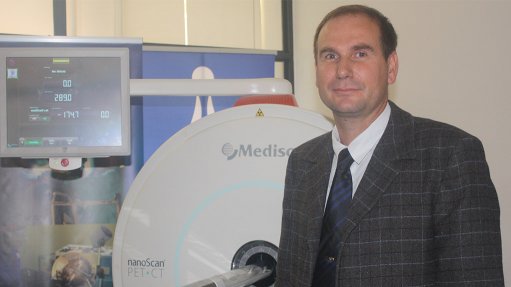
JAN RIJN ZEEVAART The microPET/CT scanner would help boost the development of new pharmaceuticals and radiopharmaceuticals in South Africa
The Nuclear Energy Corporation of South Africa (Necsa) launched the first clinical micropositron emission tomography/ computerised tomography (microPET/CT) scanner in Africa last month at its facility in the North West.
Speaking to Engineering News, Necsa Radiochemistry chief scientist Jan Rijn Zeevaart explained that the microPET/CT scanner would help boost the development of new pharmaceuticals and radiopharmaceuticals in South Africa.
With the technology, more drugs would be created and tested in South Africa, ensuring the protection of local intellectual property. South Africa would be able to establish its own drug pipeline and would no longer be reliant on imported drugs.
The third-biggest trading deficit in South Africa was pharmaceuticals, said Zeevaart, with antiretrovirals at the top of the list.
“The radiopharmaceuticals market has predicted a compound yearly growth rate of 18.3% between 2012 and 2018, with the global market valued at $3.8-billion in 2011 and reaching $12.2-billion by 2018. The main drivers for this are new PET imaging agents and therapeutic radiopharmaceuticals,” he advised.
The microPET/CT scanner was a preclinical (animal) molecular imager, which involved the medical visualisation of living animals for research purposes, such as drug development.
MicroPET took images of small animal models of diseases and was a functional imaging modality at molecular level, providing valuable insights into biochemical, physiological, pathological or pharmacological process in vivo. Data can be obtained noninvasively, repeatedly and quantitatively in the same animal.
The technology called for an investment of R6-million, with Necsa, North West University (NWU) and University of Pretoria (UP) contributing R2-million each.
The International Atomic Energy Agency had approved funding of €69 300 for training and equipment, sponsoring four fellowships based in Germany for two radiographers and two Necsa PhD students to train on the microPET/CT scanner this year.
On the back of the scanner’s launch, Necsa hoped to establish a R50-million national preclinical imaging facility that would use microPET/CT and micro single photon emission computed tomography (microSPECT) technologies for imaging small animals.
The acquisition of the microPET/CT technology was the first element of the preclinical imaging facility, in which Necsa encouraged companies, government and academics to invest.
NWU would supply animals, consisting of mice and rats, for the scanner, while radiography services would be provided by UP.
Necsa Radiochemistry would provide radiolabelled compounds fully quality-checked and ready for injection.
“There are international standards and best practices [that need to be adhered to during] the preclinical phase involving small animals. We start with mice and rats, which are specifically bred for research purposes. An NWU ethics committee, which subscribes to the national ethics board and standards, will approve all studies involving the animals,” said Zeevaart.